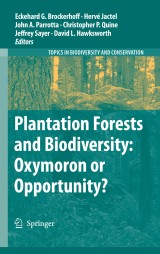Details

Plantation Forests and Biodiversity: Oxymoron or Opportunity?
Topics in Biodiversity and Conservation, Band 9
|
149,79 € |
|
| Verlag: | Springer |
| Format: | |
| Veröffentl.: | 23.07.2010 |
| ISBN/EAN: | 9789048128075 |
| Sprache: | englisch |
| Anzahl Seiten: | 288 |
Dieses eBook enthält ein Wasserzeichen.
Beschreibungen
1 Plantation forests and biodiversity: Oxymoron or opportunity? Forests form the natural vegetation over much of the Earth’s land, and they are critical for the survival of innumerable organisms. The ongoing loss of natural forests, which in some regions may have taken many millennia to develop, is one of the main reasons for the decline of biodiversity. Preventing the further destruction of forests and protecting species and ecosystems within forests have become central issues for environmental agencies, forest managers, and gove- ments. In this di?cult task science has an important role in informing policy and management as to how to go about this. So how do industrial and other pl- tation forests ?t into this? Plantation forests, comprised of rows of planted trees that may be destined for pulp or sawmills after only a few years of growth, appear to have little to c- tribute to the conservation of biodiversity. Yet there is more to this than meets the eye (of the casual observer), and there are indeed numerous opportunities, and often untapped potential, for biodiversity conservation in plantation forestry. With plantation forests expanding at a rate of approximately three million hectares per year, it is crucial to understand how plantations can make a positive contribution to biodiversity conservation and how the potentially negative impacts of this land use can be minimised. That is the topic of this book.
Plantation forests and biodiversity: oxymoron or opportunity?.- Epiphytes of Sitka spruce (Picea sitchensis) plantations in Ireland and the effects of open spaces.- Bird assemblages in pine plantations replacing native ecosystems in NW Patagonia.- Identifying practical indicators of biodiversity for stand-level management of plantation forests.- Options for biodiversity conservation in managed forest landscapes of multiple ownerships in Oregon and Washington, USA.- Impact of four silvicultural systems on birds in the Belgian Ardenne: implications for biodiversity in plantation forests.- The early effects of afforestation on biodiversity of grasslands in Ireland.- Multi-scale habitat selection and foraging ecology of the eurasian hoopoe (Upupa epops) in pine plantations.- Diversity and composition of fruit-feeding butterflies in tropical Eucalyptus plantations.- Impact of landscape and corridor design on primates in a large-scale industrial tropical plantation landscape.- Non-native plantation forests as alternative habitat for native forest beetles in a heavily modified landscape.- Importance of semi-natural habitats for the conservation of butterfly communities in landscapes dominated by pine plantations.- Relevance of exotic pine plantations as a surrogate habitat for ground beetles (Carabidae) where native forest is rare.- Stand-level management of plantations to improve biodiversity values.
<P>This book brings together a selection of original research articles that address biodiversity and conservation in plantation forests. Although such forests are perhaps the ‘poor cousins’ of the species richer natural and semi-natural forests, they can still make a significant contribution to biodiversity conservation. This is particularly the case in regions that have lost much of their natural forest cover. Comparatively few studies have previously attempted to examine the biota associated with plantation forests and, as a result, some conservation needs and opportunities highlighted here have not been adequately recognised. Conversely, plantations have sometimes been a direct cause of natural habitat loss, and greater awareness is required to avoid this with future afforestation projects. The contributions in this volume provide new information about a wide range of taxa from lichens to primates, from various temperate and tropical regions around the world, in the context of plantation forestry, combined with suggestions for forest management at both stand and landscape levels, to improve biodiversity conservation. The findings are equally of interest to the scientific community, policy makers and forest managers. The topical examples of applied conservation issues will make the volume also highly valuable for use in conservation biology courses.</P>
<P>Reprinted from <EM>Biodiversity and Conservation</EM>, volume 17:5 (2008)</P>
<P>Reprinted from <EM>Biodiversity and Conservation</EM>, volume 17:5 (2008)</P>
Draws together a wide range of peer-reviewed primary research papers from biodiversity researchers around the world Provides examples from a wide spectrum of issues representing the current state of the art in arthropods Provides examples of recent work, usable as case studies for courses in ecology, restoration, biodiversity, conservation Enables specialist researchers to see primary research papers tackling problems in arthropods
Diese Produkte könnten Sie auch interessieren:

The Vicuña

von: Iain Gordon, Jane C. Wheeler, Hugo Yacobaccio, Jerry Laker, Marcelo Cassini, Mariela Borgnia, Yanina Arzamendia, Verónica Benítez, Bibiana Vilá, Cristian Bonacic, Jessica Gimpel, Pete Goddard, Desmond McNeill, Gabriela Lichtenstein, Renaudeau d' Arc Nadine, Kristi Anne Stølen, Javier García Gomez, Ana Wawrzyk

96,29 €

Saving Biological Diversity

von: Robert A. Askins, Glenn D. Dreyer, Gerald R. Visgilio, Diana M. Whitelaw

96,29 €

Martens and Fishers (Martes) in Human-Altered Environments

von: Daniel J. Harrison, Angela K. Fuller, Gilbert Proulx

149,79 €













